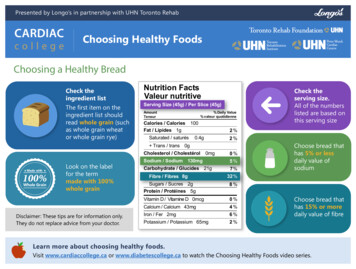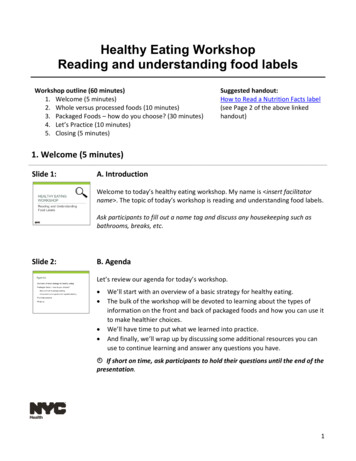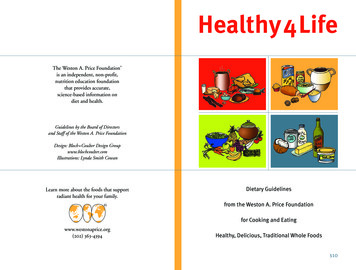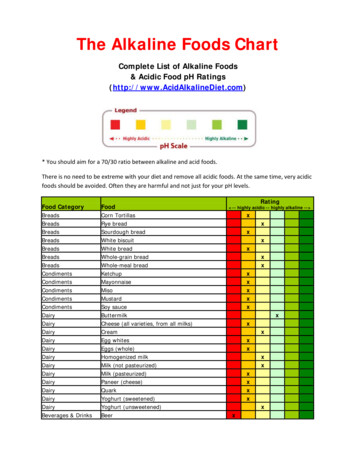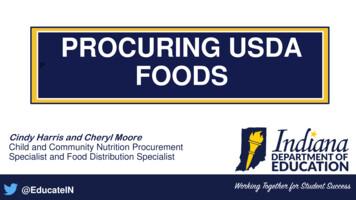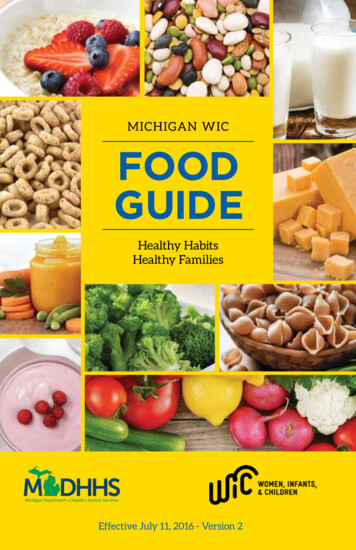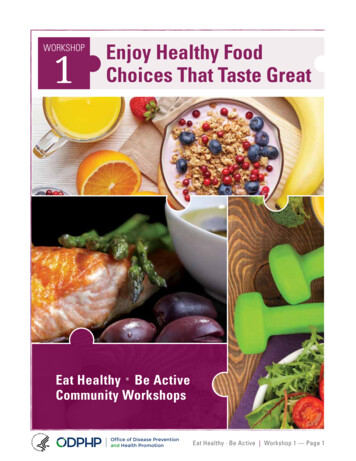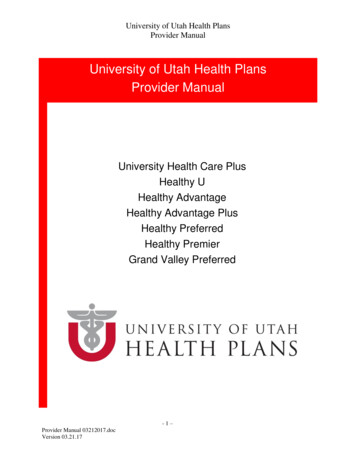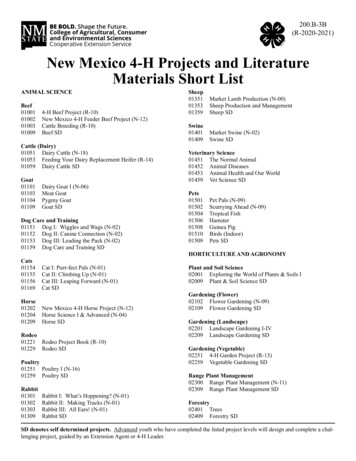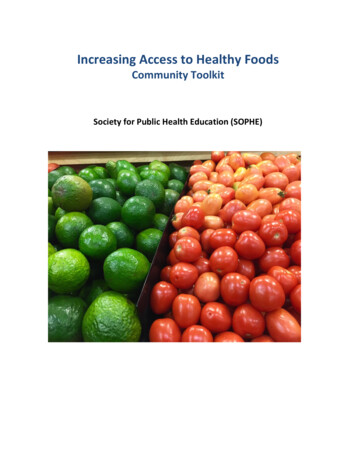
Transcription
Increasing Access to Healthy FoodsCommunity ToolkitSociety for Public Health Education (SOPHE)
AcknowledgementsThe creation and success of this toolkit would not have been possible without the time andinput provided by Ayma Rouhani, MPH candidate, graduate student intern, SOPHE, andNicolette Warren Powe, DrPH, MS, MCHES, director of health equity, SOPHE. Copyright 2015Society for Public Health Education, 10 G Street, NE, Suite 605, Washington, DC, 20002Tel. 202-408-9804 Fax 202-408-9815 www.sophe.orgPermission is granted to use any part of this guide, with the following citation:Society for Public Health Education. 2015. Increasing access to healthy foods community toolkit.Washington, DC.This toolkit was supported in part by a cooperative agreement with the Centers of DiseaseControl and Prevention (CDC) (award number 1U58DP005646-02). Portions of this work involvethe National Implementation and Dissemination for Chronic Disease Prevention supported byCDC funding. The findings and conclusions in this toolkit are those of the authors and do notnecessarily represent the views or official position of the U.S. Department of Health and HumanServices or the Centers for Disease Control and Prevention. In accordance with U.S. law, noFederal funds provided by CDC were permitted to be used by community grantees for lobbyingor to influence, directly or indirectly, specific pieces of pending or proposed legislation at thefederal, state, or local levels. Readers should be aware that every funding source has differentrequirements governing the appropriate use of those funds. Organizations should consult theirlegal counsel to ensure compliance with all rules, regulations, and restriction of any fundingsources. Web site addresses of nonfederal organizations are provided solely as a service toreaders. Provision of an address does not constitute an endorsement of this organization byCDC or the Federal government, and none should be inferred. CDC is not responsible for thecontent of other organizations’ Web pages.
Table of ContentsIntroduction11. Get Started Form a committee Assess your community’s food environment Establish objectives Create a logic model32. Take ActionBy partner Local farms Food vendors Schools OrganizationsBy activity Healthy food festival Community gardens Food co‐ops Farmers’ markets Grocery store tours Improving transportation103. Get the Word Out Define your target audience Develop your key message(s) Discover your target audience’s communication preferences21References28
IntroductionThis toolkit was created to help guide you as you work to make healthy living easier wherepeople live, learn, work, and play—with a particular focus on increasing access to healthy foods.This toolkit was specifically created for: Public health professionals and educators Community-based organizations Community residents passionate about improving the food environment in theircommunities or neighborhoodsWhy is access to healthy foods important?Healthy eating is important to a person’s overall health, including preventing illness anddisease. Poor nutrition can lead to obesity, early death, cancer, diabetes, and heartdisease.1,2,3,4,5,6,7 Over the last 30 years, adult obesity has doubled and childhood obesity hastripled—resulting in more than two out of every three Americans being obese or overweight.8Many communities — from large cities and neighborhoods to schools and business — havelimited access to healthy foods. By not having healthy food options, people must overcomeobstacles to get healthy foods, or settle for high-calorie, low-nutrient foods.1-2,5 Access tohealthy foods includes healthy foods being both available and affordable.9Did you know? Increasing communities’ access to healthy foods including fresh produce has beenshown to directly increase the population eating fruits and vegetables.6 Access to stores that offer healthy foods is associated with lower Body Mass Index (BMI)scores and lower rates of obesity.10 Farmers’ markets in a community increase the availability of nutritious foods while alsolowering household spending on food.11 Each additional meter of shelf space offering fresh vegetables in a grocery store isassociated with an increase of 0.35 servings of fresh produce per day.12By improving access to healthy foods, we can ensure food security, defined by the WorldHealth Organization as existing “when all people at all times have access to sufficient,safe, nutritious food to maintain a healthy and active life.”13Increasing Access to Healthy Foods: Community Toolkit1
Case StudyThe Centers for Disease Control and Prevention (CDC) Healthy Communities Program worksthrough local, state, national, and territorial partnerships to address health disparities andprevent chronic diseases like diabetes and heart disease. One of the main focuses of theprogram is healthy eating. As a result of the program’s efforts, many communities have madechanges to improve access to healthy foods.Some of these successes include: More than 550 parks in Chicago, Illinois, now have vending machines that offer 100%nutritious items. All city agency events and meetings in Miami, Florida, provide healthy snacks andbeverages such as water and granola bars. Rural Montgomery County, Alabama, created nine community gardens to providesurrounding neighborhoods with healthy and fresh fruits and vegetables. Eastern Highlands, Connecticut, serves all its pre-kindergarten students with healthysnack options every day. Grand Rapids, Michigan, created new farmers’ markets and several new school- andcommunity‐based gardens in low-income communities to increase the availability ofnutritious produce.Increasing Access to Healthy Foods: Community Toolkit2
Get StartedIf you aren’t already working with an organization or coalition, here are some steps to getstarted:1. Form a committee.2. Assess your community’s food environment.3. Establish objectives.4. Create a logic model.Step 1: Form a committeeThe first thing you can do to start improving access to healthy foods in your community is toform a Healthy Foods Committee that can work to address this important issue.The purpose of a Healthy Foods Committee is to plan and coordinate activities andinterventions that will promote community-wide changes and improve access to healthy foods.The committee can be comprised of community residents, community leaders, local farmers,school and hospital administrators, local business owners, and other individuals andorganization representatives who are invested in this health issue.The team can be location specific by targeting a certain neighborhood, county, or ZIP code, or itcan focus on a specific organization or setting such as a hospital or school.The committee can:14 Conduct a food assessment of your community. Form an action plan with a timeline and specified objectives, goals, and strategies. Support existing initiatives in your community with training and partnerships. Monitor new programs or activities. Communicate successes, positive changes, and best practices to organizations,businesses, and the greater community to further encourage healthy changes. Evaluate activities to measure impact.Who can join the committee?It’s important that your Healthy Foods Committee include a diverse representation ofindividuals and organizations. This will help spread group responsibilities and ensure a varietyof viewpoints and perspectives are included. This is key to identifying and using effective, longlasting, sustainable strategies.You can invite:14 Public health department staff Wellness coordinators Purchasing directorsIncreasing Access to Healthy Foods: Community Toolkit3
Agency leadersCommunity leadersStaff from legal departmentsSchool administratorsFood service staffNutritionistsEvaluation staffFood vendorsCommunity residentsRepresentatives from local businessesHospital administratorsCounty plannersHealth communication specialistsHealth educatorsTip: It can be helpful to decide on a regular meeting date that works best for most of thecommittee—and to stick to the meeting date and try not to exceed the time allotted for themeeting. For example, have a standing meeting on the first Monday of every month. Byhaving a set date, your committee can regularly communicate and work together. Plus itmakes it easier for members to remember to attend the meeting.Increasing Access to Healthy Foods: Community Toolkit4
Step 2: Assess your community’s food environmentOnce you have formed your committee, it is important to learn more about your community’sfood landscape. To do this, you can conduct a food assessment. The food assessment needs tofocus on the geographical area where your committee is dedicated to improving access tohealthy foods. This may be an entire city, a neighborhood, or a smaller location, such as aschool, workplace, or hospital.Conducting the food assessment and analyzing the results canhelp your team identify: Gaps that need to be addressed Strategies that may be effective in addressing gaps Potential partners Community assets and resourcesThe next few pages include guidelines on how to conduct a foodassessment and identify free tools and resources that you canuse to help you gather information about the food environmentin your community.What is a community foodassessment?A community foodassessment is a process thatallows you to identify areaswith limited access to healthyand fresh foods to helpcommunities plan moreeffective healthy foodinterventions.15Questions to askBelow are sets of questions to incorporate into your food assessment to better understand thefood environment in your community.1. Assess your community’s perceptions and behaviors regarding food purchasing and eatinghabits.16 Where do community members get their food? What is the quality of the food offered? How does your community compare to others in terms of food items offered? What are the purchasing and eating habits of your community? What does your community know about the importance of healthy eating and selectingnutritious foods? What barriers do community members believe prevent them from accessing healthyfoods? How can you educate community members about healthy food purchasing andpreparation? If healthy foods are available, why aren’t community residents purchasing them? How do community members think access to healthy foods can be increased?2. Look at the number and location of grocery stores and healthy food outlets in yourcommunity and determine how easy or difficult it is for people to get to them. Are they accessible by public transportation or on foot? Is the public transportation reliable, safe, and affordable?Increasing Access to Healthy Foods: Community Toolkit5
Is it safe to walk to these locations?3. When looking at a specific building, find out how many vending machines, snack bars, orother food-providing facilities are available and investigate whether they offer healthy options. Are low‐sugar beverages provided? Do beverage options include milk, 100% fruit juice, and water? How many healthy options are available compared to junk-food items? Are snacks offered that are high in nutrients (e.g., protein, vitamins, fiber)?4. Identify what settings and partners will help promote access to healthy foods. Are there individuals in the community with a strong passion for and interest in healthyfoods who can serve as valuable resources? Are there individuals interested in forming their own businesses? How many farmers work in your community and can provide fresh produce? Is there a strong level of community support?5. Identify the challenges you may face when using strategies to increase access to healthyfoods. Is there a lack of understanding of the importance of nutritious and healthy eating? Do some staff or community members appear to be resistant to healthy changes? Why? Are systems conducive to healthy eating already in place but not being properlymonitored or supported?6. Identify what settings and partners will be important to work with to improve access tohealthy foods. Are some community members interested in developing a new healthy food outlet suchas a farmers’ market or grocery store? Are health professionals such as community health workers, nutrition experts, healtheducators, and health care providers willing to partner and work with your team toimprove nutrition and healthy eating?7. Assess what trainings, facilities, and supplies may be beneficial for staff so they can startimplementing new strategies. Does food service staff require additional training on how to prepare and purchasehealthy food items? Do buildings need additional refrigeration or food preparation areas?Increasing Access to Healthy Foods: Community Toolkit6
Facilities to examineWhen you are conducting your food assessment there are many facilities you can focus on,including:14 Cafeterias: facilities that provide prepared foods (can include hot meals) and drinks,usually through a line where customers select and serve food items themselves; can befound in locations such as schools, workplaces, or hospitals Vending machines: automatic facilities that dispense food items when currency isinserted; usually do not include eating accommodations or an onsite supervisor Concession stands, snack bars, and carts: facilities that usually offer previouslyprepared food items for a light meal such as sandwiches and salads; include an onsitemanager and can sometimes have eating accommodations Patient meals: meals provided to patients in a hospital or to patients in a long-term carefacility Meals served in institutions: meals provided to individuals in nursing homes, prisons,and psychiatric hospitals Distributive meals: meals provided through after-school snack programs, child carefacilities, soup kitchens, or home delivery for seniors or childrenNote: You can find these facilities in different buildings and locations such as hospitals, schools,community centers, parks, and workplaces.Tools You Can UseUSDA Food Environment vironment-atlas/go-to-the-atlas.aspxUse this map to find statistics on your community’s food environment, including: Food choice indicators such as access and proximity to a grocery store, number offood stores and restaurants, and expenditures on fast foods Health and well-being indicators like rates of food insecurity, diabetes, obesity, andphysical activity Community characteristics including demographics, income and poverty levels, andaccess to recreation and fitness centersUSDA Food Access Research cess-research-atlas/go-to-the-atlas.aspxUse this map to find out about: Access to sources of healthy foods by distance to stores in the specified area Individual-level factors that influence accessibility (e.g., family income) Neighborhood-level factors (e.g., public transportation access and average income)Increasing Access to Healthy Foods: Community Toolkit7
Step 3: Establish objectivesOnce you and the committee have conducted a food assessment to identify gaps, assets, andopportunities, you can develop objectives that will help you select effective activities to createchange.To begin, think about these questions from the CDC:17 WHAT are we going to do? WHY is it important for us to accomplish this activity? WHO is going to be responsible for the activities? WHEN do we want this to be completed? HOW are we going to do these activities?Then you can establish SMART objectives, which are:17 Specific: Describe your objectives in detail and beconcrete so you know exactly what you areworking toward and have clear expectations. Measureable: Quantify your objectives usingnumbers so you can measure progress andachievements. Achievable: Make sure your objectives are feasibleand possible to meet. Realistic: Think about factors such as yourresources, costs to meet your goals, personnel,and the time frame you are working within toensure that your objectives can be met. Time‐Bound: Establish a time frame for goals tohelp structure your plan for achieving objectives.Tip: When you’re creatingobjectives, try starting them withverbs such as: Assess Create Decrease Demonstrate Evaluate Identify Implement Increase PlanExamples After two years, County X will open at least five new local farmers’ markets with freshfruits and vegetables available to County X residents at an affordable cost. By the end of this year, a new shuttle will provide residents in Community Y with freebus rides to and from local grocery stores and residential areas.Tools You Can UseDevelop SMART ekit/evaluate/smart objectives.htmlIncreasing Access to Healthy Foods: Community Toolkit8
Step 4: Create a logic modelOnce you have identified your objectives, it is important to map out specific components ofyour program. One way to do this is by creating a logic model to visually display factors such asthe resources needed for your program, activities, influences, outputs, and initial, intermediate,and long‐term outcomes.Some benefits of creating a logic model include:18 Having a clear vision for your program Identifying how each objective and activity supports your program goal Thinking about how you want to use resources and assign responsibilities Creating a framework that can be used for program evaluationSample logic modelTools You Can UseLogic Model /evallogicmodelworksheets.htmlIntroduction to Program Evaluation for Public Health Programs: A Self-Study creasing Access to Healthy Foods: Community Toolkit9
Take ActionThere are many ways to improve access to healthy foods in your community. This sectionprovides ideas by partner and by activity.As you begin planning to improve access to healthy foods in your community, remember tofocus on particularly vulnerable populations. Every community is unique and requires a set ofstrategies that takes into account particular assets, needs, and community interests. Workingdirectly with community residents and community leaders can help ensure that you tailoractivities and strategies in a way that is effective and sustainable.By partnerGet ideas for improving access to healthy foods by working with partners including: Local farms Food vendors Schools OrganizationsLocal farmsWhen working to increase access to healthy foods, it is important to involve local farmers. Theysupport the sustainable production of healthy and fresh produce and food—and can helpincrease access to healthy foods in the local community.You can: Locate farmers in your community and invite them to be members of your HealthyFoods Committee or to partner in your initiatives. Support farmers by expanding their production capabilities, connecting them to venues(e.g., schools, cafeterias, restaurants) where they can sell their produce, andencouraging individuals interested in farming to pursue their interests by connectingthem with supportive resources. Listen to and learn about your local farmers to help identify assets and opportunities forgrowth that can lead to sustainable and healthy changes in your community.Tools You Can Usestart2farm.govhttp://www.start2farm.gov/This resource can provide farmers with helpful tools and programs to help them succeed intheir first few years of farming. This site provides a database of programs and resources withtailored information such as education and training, finance support, and networking.Increasing Access to Healthy Foods: Community Toolkit10
USDA Know Your Farmer, Know Your avid KYF GRANTSFind funding opportunities to support: Farmers hoping to extend a growing system Farmers’ markets that want to accept SNAP benefits Providing community kitchens with storage for food itemsFood vendorsFood venue staff, such as managers or owners of grocery and convenience stores, can beimportant partners to help increase community access to healthy foods. You and your team cancollaborate with these partners and provide support to both increase the selection of healthyfood items and improve consumer access to and identification of the healthy food items.When meeting with local grocery store owners and managers, consider discussing options to: Invite local food venue partners to be members of your Healthy Foods Committee. Encourage and work with food venue staff to hold in-store demonstrations of healthyfood items, to provide healthy recipe handouts, and to help customers read andunderstand nutrition labels. Discuss the placement of food items and work with food venue partners to displayhealthy food options more prominently and at eye level.14 Encourage consumer taste tests of healthy foods. Hold a training workshop for community members interested in opening up a healthyfood–related business in order to connect them with resources and contacts that cansupport their business endeavors. Explore whether or not local food venue staff can discount healthy food items orprovide coupons for healthy options.Case StudyThe Pennsylvania Fresh Food Financing Initiative was successful in improving the foodenvironment in Pennsylvania through a public-private partnership between theCommonwealth of Pennsylvania, the Reinvestment Fund, and the Food Trust. After six years,the initiative resulted in:19 88 new or improved grocery stores in underserved communities 400,000 residents with increased access to healthy food 5,000 jobs created or retained 540,000 increase in local tax revenue from a single store in Philadelphia 190 million total project costs resulting from 30 million state seed moneyTo learn more or to contact the organization for more information, amilies/PA FFFI.pdf.Increasing Access to Healthy Foods: Community Toolkit11
Tools You Can UseSmart Food Choices: How to Implement Food Service Guidelines in Public lines.pdfHealthier Food Retail: Beginning the Assessment Process in Your State or ssessment.pdfSchoolsImproving access to healthy foods for students in a school setting is another way to improve thehealth of your community. Obesity has increased dramatically over the past few decades,particularly among children.20,21,22 A major contributor to the rising rates of childhood obesity isthe consumption of unhealthy foods and beverages, which are often made available in theschool setting.23 Improving the quality of foods offered in the school setting can be beneficialin improving children’s health. Recent research shows that students in states with strongnutrition standards regarding school foods such as drinks and snacks experienced less weightgain over three years than students in states without similar nutrition standards.24Did you know?Today about one in three children from ages eight to 19 years old are either overweight orobese, and have an increased probability of developing chronic diseases (such as diabetesand heart disease) and having psychosocial problems.20,21,22Students often consume a good portion of their calories, about 35% to 50%, at school.21,25Studies have found a strong association between a child’s diet and nutrition and his or heracademic performance and success.21,26,27,28,29,30What you can do to improve access to healthy foods in schoolsBelow are recommendations on what you can do, through partnerships with local schools andadministrators in your community, to increase access to healthy foods in schools: Limit the sale of sports drinks.21 Limit the availability of caffeinated products.21 Set school standards that require food and beverages sold for fundraisers to meetnutrition guidelines.21 Provide trainings to school food service staff on the importance of healthy eating andnutrition, and how to order and prepare healthier food items. Connect local farmers to food service staff and school administrators to facilitate aschool partnership that enables farmers to sell their produce to schools.Increasing Access to Healthy Foods: Community Toolkit12
Apply for a Farm to School Grant from the USDA to help you fund partnerships betweenlocal farmers and schools. For more information hool-grant-program.Train teachers and school administrators on healthy eating and nutrition—and addresshow these topics can be incorporated into school curricula.Work with vending machine providers to replace vending machine items with healthieritems.Work with teachers and school administrators to plant school gardens that studentshelp run.Case StudyAs part of the CDC’s Communities Putting Prevention to Work initiative—an initiativedeveloped to promote local strategies for healthy living—Hamilton County, Ohio, targeted 22school districts to increase access to healthy foods and beverages in schools.31 As a result ofthe initiative, more than 50 schools and 50,865 students have access to nutritious foods andsnacks through vending machines, à la carte items, and school stores.31 Hamilton alsoincreased the availability of affordable and healthy foods by forming 20 church‐basedcommunity gardens, with the majority in low-income areas.31To learn more or to contact the organization for more information, visit:http://bit.ly/1KuZd0W.Tools You Can UseState and National School Snack ol-snack-policiesLearn what state policies are in place around healthy snacks in schools.Let’s Move Salad Bars to Schoolshttp://www.saladbars2schools.org/View tools and grant opportunities to get a salad bar in your school.USDA Farm to School Planning /f2s/F2S Planning Kit.pdfUse this step-by-step guide to create a farm to school program.OrganizationsYou can work with local organizations and institutions to improve access to healthy foods. Forexample, you can partner with faith-based organizations, local businesses (both big and small),workplaces, non-profit organizations, hospitals, parks and recreational facilities, andIncreasing Access to Healthy Foods: Community Toolkit13
community centers to address food options available to members, staff, volunteers, andcustomers. Conduct research to determine if an organization’s goals and objectives align withyour project.When reaching out to partner with these organizations, find a contact person like a humanresources representative, manager, or administrator by calling, going online, or stopping by inperson. After introducing yourself, your initiative, and objectives, invite him or her to partnerwith you to improve the health of the community.As you develop strategies to work with an organization, business, or food venue to improvehealthy options, try to:32 Encourage executives and leaders to think about the message the organization issending to the public and staff through the food and beverage items it offers. Believe in your intervention and strategies so that your passion motivates and inspiresothers. Remember that support from leaders is important to your intervention’s success. Motivate staff, employees, and partners to make and maintain healthy changes. Cultivate strong relationships with food service and wellness staff to create healthypractices and policies for everyone. Review and assess food and beverages contracts. If a contract is not specific about whatfood items and beverages must be purchased, there is flexibility to request healthieroptions. Even if a contract is specific, you can attempt to revise or update it. Provide training to food service staff on measuring ingredients—this can ensure that thenutrition information of foods is accurate, and it helps cut waste and costs. Listen to consumer preferences about the healthy foods they like and will purchase. Increase awareness to make healthy living easier where people live, work, learn and play.Case StudyThe New Mexico Diabetes Prevention and Control Program created a “Kitchen CreationsCooking School” to educate community members on healthy food preparation and planningskills through four interactive classes.33 The classes cover topics including meal planning;balancing carbohydrates; using vegetables, beans, and whole grains; and heart healthycooking.34In recent years, participants in the program increased their: Consumption of whole grains or beans by 92% Intake of two or more non‐starchy vegetables during meals by 142% Use of food labels by 98%33Kitchen Creations is sponsored by the New Mexico Department of Health, Public HealthDivision, Diabetes Prevention and Control Program, and the New Mexico State UniversityCooperative Extension Service.34Increasing Access to Healthy Foods: Community Toolkit14
To learn more or to contact the organization for more information, y activityConsider these activities as you make a plan to improve access to healthy foods in yourcommunity: Healthy food festival Community gardens Food co‐ops Farmers’ markets Grocery store tours Improving transportationHealthy food festivalHost a healthy food festival to showcase healthy foods in the neighborhood. Invite local grocery stores, healthy restaurants, farmers, and other healthy food vendorsto participate in the event. Let them know the event will be great publicity! Advertise! Promote the event through social media and flyers. At the event, provide handouts with healthy recipes and coupons for healthy fooditems. You can encourage vendors to do the same. Offer taste tests of healthy foods (e.g., smoo
obstacles to get healthy foods, or settle for high-calorie, low-nutrient foods.1-2,5 Access to healthy foods includes healthy foods being both available and affordable.9 Did you know? Increasing communities’ access to healthy foods including fresh produce has been shown to direct

